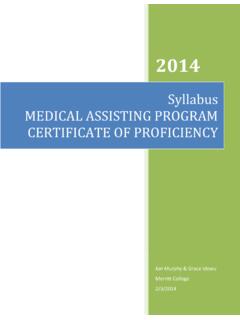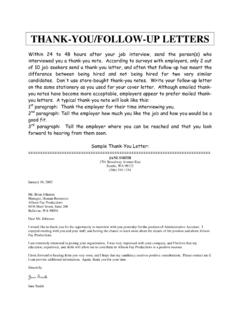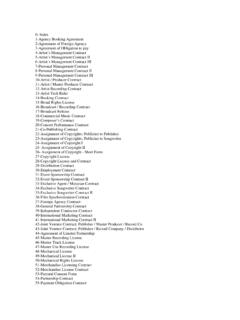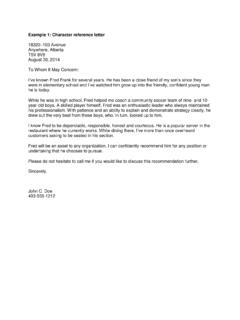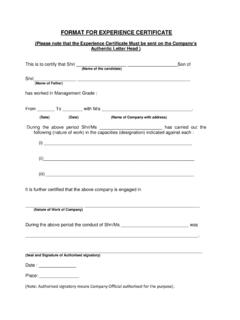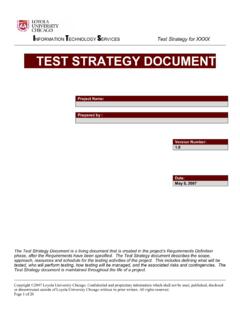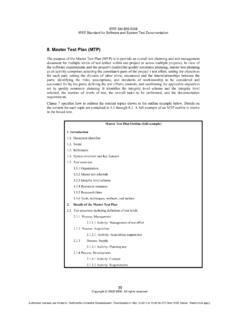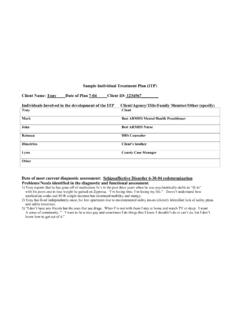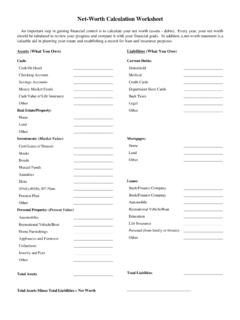Transcription of Financial Planning for Small Business
1 Financial Planning for Small Business Alberta Economic Development and Tourism Foreword FOREWORD. Financial Planning for Small Business is designed to provide an introduction to the basics of Financial Planning . It is one in a series of guides which has been developed and published by Alberta Economic Development and Tourism (ED&T) to assist Small Business owner/. operators in Alberta. The other guides are the following: Starting a Small Business Starting a Home-Based Business Marketing for Small Business Managing a Small Business Recordkeeping for Small Business These publications are available at all ED&T offices listed in the back of this publication. Before developing a Financial plan for your Small Business , you may wish to consult with an accountant, lawyer, Business mentor, Business management consultant, educational institution, government agency, Business or other association suitable to your type of Business .
2 Various federal, provincial, and municipal agencies also provide counselling and advice on Financial Planning for Small Business . Please check for services in your area. This Small Business Series is supported by Western Economic Diversification Canada (WD), the federal department responsible for leading and coordinating federal economic activities in western Canada. The Business guides are available through WD's network of Business services listed in the back of this publication. Alberta Treasury Branches has also supported the production of this guide series. The guides are available at any of the Treasury Branch locations listed in the back of this publication. This material is the property of the Government of Alberta and is protected by copyright. It is not to be reprinted, photocopied or otherwise reproduced without the 2 written permission of the Government of Alberta.
3 Table of Contents Table of Contents FOREWORD 2. TABLE OF CONTENTS 3. INTRODUCTION 5. ONE: Financial Planning 6. Start-up Costs 6. Cash Flow Projections 7. Preparing a Cash Flow Projection 7. Income Statements 8. Balance Sheets 8. Break-even Analysis 9. Business Ratio Analysis 10. TWO: METHODS OF FINANCING YOUR Business 12. Equity Financing 12. Personal Investment from Self, Friends, and Relatives 12. Partner Investment 12. Shareholder Investment 13. Employee Investment 13. Venture Capital 14. Debt Financing 14. Business Term Loans (Financing Fixed Assets) 15. Operating Loans (Financing Working Capital) 16. Comparing Equity and Debt Financing 17. THREE: INTERNAL AND OTHER TYPES OF FINANCING 18. Internal Sources of Financing 18. Collecting Accounts Receivable 18. Reducing Inventory 18. Prepayment Agreements 19.
4 Other Sources of Financing 19. Leasing Fixed Assets 19. Conditional Sales Purchases 20. Sale-Leaseback Arrangements 20. Factoring 20. Supplier (Trade) Credit 20. 3. Table of Contents (continued). FOUR: HOW TO APPROACH LENDERS 21. Some Key Questions Before You Borrow 21. Does Your Business Really Need to Borrow Money? 21. How Much Does Your Business Need to Borrow? 22. How Fast Should You Repay Your Loans? 22. Understanding the Loan Approval Process 22. What Lenders Are Looking For 24. If Your Application is Rejected 24. Establishing a Positive Relationship With Your Lender 25. Why Business Loans Sometimes Become Problem Loans 26. APPENDIX A: Financial Planning WORKBOOK 27. 1. Start-up Costs Worksheet 27. 2. Cash Flow Projections Worksheet 28. 3. Sample Cashflow 29. 4. Sample Income Statement 30. 5. Sample Balance Sheet 31.
5 6. Break-even Chart 32. APPENDIX B: ALBERTA ECONOMIC DEVELOPMENT. AND TOURISM OFFICES 33. 4. Introduction Introduction Financial Planning is at the heart of every successful Business . A Financial plan, which includes detailed Financial statements and projections, forms the core of your overall Business plan. For more information on preparing a Business plan, refer to ED&T's Starting a Small Business . Financial Planning should be completed at least once a year and revised monthly to incorporate actual results. It has two main purposes: 1. It enables you to make sound Business decisions about what Financial resources your company actually needs, and about what Financial moves your company needs to make, to be successful. 2. It helps you plan for and obtain the necessary financing to establish your Business , continue its operation, and help it grow.
6 Solid Financial Planning demonstrates to potential investors and lenders that you are Planning for success and that you are serious, thorough, knowledgeable and realistic. In addition to impressing upon investors and lenders that you have done your homework and thought through your Financial plan, the actual plan allows them to quickly evaluate the following: The short and long term prospects for your Business Your company's profit potential Your company's strengths and weaknesses Future opportunities and challenges The amount and type of financing your Business will need to be successful This publication will help you understand the basics of Financial plan- ning. Chapter One describes and provides examples of the key elements of your Financial plan. Chapter Two deals with the two main sources of financing for your Business : equity and debt.
7 Chapter Three covers internal sources and other methods of financing. Chapter Four describes how to approach lenders and investors. 5. Financial Planning One: Financial Planning Your Business will only be as strong as its Financial plan. For your Financial plan to attract investors and be valuable as a Business Planning tool, it must be based on reliable numbers and careful calculations. Your Financial plan should include: Start-up costs, if you are starting a new Business Cash flow projections Projected (pro forma) balance sheets and income statements Balance sheets and income statements for at least the previous year (if your Business is already in operation). A break-even analysis A ratio analysis (if your Business is already in operation). Remember that current Financial statements are based on the actual numbers which describe your company's Financial performance over the past year or years.
8 Financial projections look into the future and estimate, as realistically as possible, the future performance of your company. When completing Financial projections, it is advisable to use best, worst, and most likely scenarios. If your Business is already in operation, your accountant can easily prepare your Financial statements, provided your bookkeeping records are accurate and up-to- date. For more information on bookkeeping and overall recordkeeping, refer to ED&T's Recordkeeping for Small Business . Your accountant or a Business consultant can help you prepare your Financial projections. The Business sections of libraries and bookstores also provide guidance materials for completing your Financial statements and projections. Start-up Costs If you are starting a new Business , first determine start-up costs.
9 These are one-time expenditures that your company must make before it opens its doors for Business . Included are such costs as equipment, furniture, fixtures, supplies and materials, inventory, renova- tions (leasehold improvements), licences, permits, and incorporation fees (if applicable). Expenses incurred after the opening date are called operating expenses and will appear in your company's income statements and cash flow projections. Once your Business is in operation, you will require adequate funds to finance your new Business from start-up until monthly cash flows are positive. (See Cash Flow Projections below.). In Appendix A, you will find a start-up costs worksheet. Use it to complete your own start-up cost projections. 6. Financial Planning Cash Flow Projections A cash flow projection or forecast is an estimate of when you expect to receive cash from your sales and, therefore, when you expect to pay bills.
10 It is a critical part of your Financial Planning and Business plan because it shows how much money will flow into and out of your Business each month. Cash flow projections are usually done for each month and at least one year into the future. A cash flow projection is an important management tool because it does the following: 1. Estimates the amount of money necessary to finance month-to-month Business operations. 2. Enables you to plan for the times when revenue will not be sufficient to cover expenses. 3. Demonstrates to potential lenders that you expect to have sufficient revenue to repay loans on a regularly-scheduled basis. 4. Can be used to compare estimated and actual cash flows on a monthly basis. This will allow you to constantly adjust your cash flow projections and identify potential problem areas.
